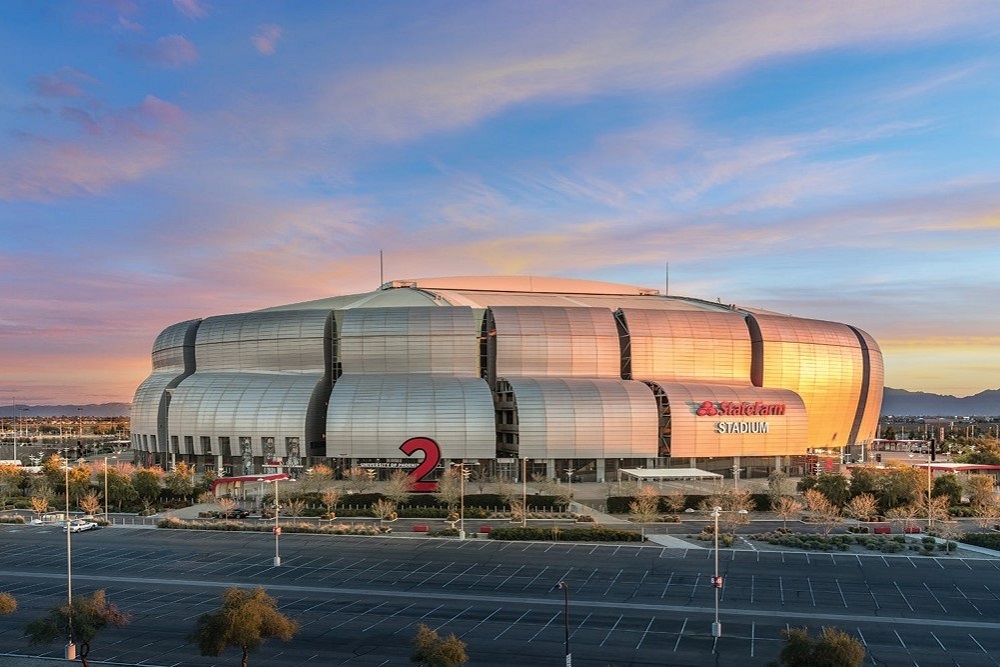Glendale, Arizona’s State Farm Stadium, home of the NFL’s Arizona Cardinals, is about 10 miles from downtown Phoenix and will be the home of the ultimate thrill of victory and the agony of defeat for the remaining four teams of March Madness, as the NCAA Basketball Men’s Final Four and championship games will be held there April 6–8, 2024.

The University of Alabama’s Crimson Tide faces the University of Connecticut (UConn) Huskies, and North Carolina State’s Wolfpack will play against Purdue University’s Boilermakers for the Final Four on April 6, with the winners of those two games playing each other for the championship on April 8.
Whether you’ll be lucky enough to watch the exciting action of the Final Four games from a stadium seat or choose the comfort of your home or your neighborhood bar, you’ll likely be rooting for your favorite college basketball team to cut down the nets and be crowned the 2024 national champion. While the players on the floor are where the action is, facilities professionals worldwide will be focused on the star of the show: State Farm Stadium.
Stadium Stats
- Name: State Farm Stadium
- Location: Glendale, Arizona
- Owner: Arizona Sports and Tourism Authority (AZSTA)
- Operator: ASM Global
- Project cost: $455 million
- Seating capacity: Fixed seating of 63,400; can accommodate over 73,000 with customizable seating
- Size: 1.7 million square feet (sq ft)
- Size (field event space): 109,600 sq ft
- Concourse levels: 3
- Year opened: 2006
- Renovations: 2014, 2018, and 2024
- Primary uses: Cardinals (2006 to present) and Fiesta Bowl College Football Playoff (CFP) (2007 to present)
- Other uses: concerts, trade/consumer shows, corporate events, and major sporting events, such as three Super Bowls (2008, 2015, and 2023), the 2016 CFP National Championship, the 2016 Copa America Centenario, and the 2017 NCAA Men’s Final Four
What’s in a Name?
State Farm Insurance Company purchased naming rights for the facility in 2018 for an 18-year agreement at an undisclosed cost. The cost to change the signature sign on the stadium’s exterior, a vertical marquee sign, and the sign on the dome’s roof was unclear.
From 2006 to 2018, it was known as the University of Phoenix Stadium, named after the university, which had previously signed a 20-year-long naming rights deal for $7.7 million a year. The university remains an educational partner of the facility.
The facility was known simply as the “Cardinals Stadium” during its construction.
Unique Features
Eisenman Architects, which was involved with the stadium’s architectural work, says the stadium has “alternating sections of metal panels and recessed vertical glass bands that allow views out from the circulation concourse.” It also has an exterior design that, according to stadium officials, looks like a “snake coiled around a barrel cactus” and features a retractable roof and field.
Retractable Roof
State Farm Stadium’s 500,000-sq-ft roof has a 100,000-sq-ft section, with two bi-parting retractable roof panels supported by two 87-foot-deep “Brunel trusses” spanning 700 feet between concrete super columns to form the primary structure of the roof, according to Walter P. Moore, which provided structural engineering services.
The stadium’s retractable roof was constructed with translucent Bird-Air fabric and moves along steel rails. It uses eight cable drums—each powered by four 7.5-horsepower motors that wind up a one-and-a-half-inch-diameter cable, which moves each panel. In total, the two roof panels are powered by a 480-horsepower system.
“State Farm Stadium was the first in North America with both a retractable roof and retractable field,” according to Populous (formerly HOK Sport), which did the facility’s architectural and interior design services.
Retractable Field
The facility’s retractable field, made with Tifway 419 natural grass, is contained in a tray measuring 234 feet wide and 403 feet long, with a depth of 40 inches. The field rolls on 546 steel wheels, gliding on 13 railroad-like tracks. The field can be moved 740 feet in or out of the stadium in 70 minutes so it can get sun exposure outside the stadium and so the stadium floor can be used for events.

“This versatility and attention to detail make the retractable field at State Farm Stadium a true marvel in the world of sports venues,” according to a statement on the stadium’s website.
Renovations and Technology Upgrades
A planned $15 million facility upgrade will bring premium seating, including field-level suites and club areas, to both end zones.
Those upgrades come after an ambitious, approximately $100 million, 8-year project, which occurred between Super Bowl XLIX in 2015 and Super Bowl LVII in 2023, that included:
- $28 million of renovations, with new food and beverage areas, upgraded offerings at existing bars and restaurants, new flooring, new lighting, new TVs, a new sound system, new furniture, nursing rooms, and renovated restrooms;
- $28 million for a 4,015-space parking lot, a pedestrian tunnel and bridge, and permanent shaded structures for security checkpoints;
- $6.7 million that upgraded stadium production systems and technology, made parking lot improvements, and improved and added concessions;
- $2.4 million for a field tray upgrade, which replaced waterproofing and drainage systems, along with the sod and root-zone mix;
- $1 million for a grassy field space for food trucks and pregaming activities; and
- $35 million for stadium upgrades, which included Verizon, T-Mobile, and AT&T 5G cellular service and Wi-Fi upgrades; a brand-new video board and scoreboard with 3.5 million pixels of resolution; and touchless technology for ticketing, concessions, and parking.
“We want to make sure the building constantly feels fresh,” Cardinals President and Owner Michael Bidwill told AZCentral.
Sustainability
In October 2023, State Farm Stadium announced on its Facebook page that its “fourth round of LED light conversion” had been completed. The conversion includes lighting that not only has superior brightness but also is energy-efficient, reducing the facility’s carbon footprint.
12News reported that State Farm Stadium cuts down on waste by employing workers to go through the trash in the stadium after games and sort recyclable paper trash from the rest.
Safety & Security
State Farm Stadium has a focus not just on addressing previous fire safety issues and being safe but also on providing security for its fans.
Fire Safety
After the building failed 87 out of 190 fire code inspections from 2017 to 2022, with issues like fire alarm troubles, blocked exit doors and fire lanes, improperly located fire extinguishers, and a missing fire safety plan, the stadium fixed those issues and is focused on being proactive.
State Farm Stadium General Manager Andy Gorchov told ABC15 in 2022, “This stadium is inspected probably more than any other NFL stadium in the country,” as the Arizona Office of the State Fire Marshal checks all the facility’s systems before every event, as well as conducts annual inspections.
To elaborate on fire safety prevention measures, a spokesperson from State Farm Stadium told 12News in 2023:
“A building the size of State Farm Stadium has a vast and complex fire safety system. When code violations are identified, we work closely with the authorities to ensure that violations are corrected in a timely fashion.
The purpose of the stadium’s comprehensive fire safety inspection program is to take a proactive approach to potential issues that may arise in the system, and State Farm Stadium staff is vigilant in addressing them.
Safety is the number one priority at State Farm Stadium. The stadium is one of the most frequently inspected buildings in the state, with inspections taking place an average of three times per month.”
The statement further promised there will be a “significant fire safety presence on-site” for every game and major event, which will include a specialist to monitor the building’s fire safety systems.
Fan Security
Those entering State Farm Stadium should be prepared to go through two security checks:
- Staff will check the size and type of all bags to ensure they meet clear bag policy requirements. The only non-clear bags allowed are those 4.5” x 6.5” or smaller. Otherwise, clear plastic, vinyl, or PVC bags are allowed if they don’t exceed 12” x 6” x 12”.
- Contents of accepted bags will be searched, and fans must walk through a metal detector or be screened with a hand-held device, as is the case in most arenas and stadiums.
Exceptions are made for items that are medically necessary.
A Facility That’s a Slam Dunk
Its retractable roof and field, along with recent and upcoming facility renovations, sustainability, fire safety initiatives, and the clear bag policy, make State Farm Stadium a venue like no other.
Playing in a facility this enormous is quite the treat for the NCAA Men’s Final Four this year. This facility hosted the NCAA Final Four in 2017, when the North Carolina Tar Heels won the championship, beating the Gonzaga Bulldogs. It also hosted Super Bowl XLII in 2008, when the New York Giants narrowly defeated the New England Patriots, as well as Super Bowl XLIX in 2015, when the New England Patriots won the big game over the Seattle Seahawks. The facility additionally hosted Super Bowl LVII in 2023, when the Kansas City Chiefs beat the Philadelphia Eagles.
Additional information on State Farm Stadium can be found by clicking here.
